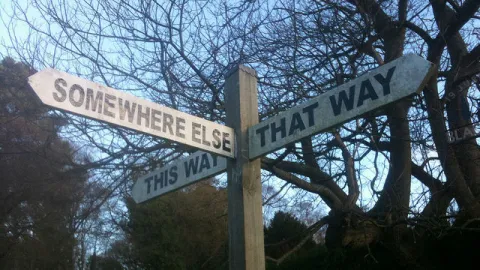Battleground:Education – Who’s ‘The Decider’ for Public Schools?

This article is part of Battleground:Education, an ongoing series on educational innovation.
In a recent big think profile, New Jersey’s Acting Commissioner of Education Christopher Cerf observed that consensus “is not the highest value in this world” and that “putting too high a premium on consensus and collaboration” could lead to bad solutions.
This may be true when it comes to corporations. But Mr. Cerf wasn’t discussing corporate restructuring; he was talking about making fundamental changes to the public education system within our democratic society.
Mr. Cerf referred to his preferred approach as one of “damn the torpedoes, full speed ahead,” and dismissed any criticism or alternatives as coming from advocates “for the status quo.” The questioning, however, is not by monied special interests but by public school parents and other voters who disagree with Mr. Cerf’s methods and his objectives for their children’s schools.
Public education is a communal good, like public roads, law enforcement, and national defense. Such communal goods are paid for by all of us, regardless of whether we use them, and must be controlled via democratic decision-making that reflects the will of the majority while ensuring equal rights for the minority.
It is this communal aspect of public education that has been under the greatest attack of late; primarily from advocates of public school privatization promoting “parental choice.” This framing treats public education less as a collective good, like public safety, and more as a personal one, like a sweater. In doing so, it reduces parents and children to consumers, and limits their agency to selecting which sweater to buy. All other decisions are left to omnipotent leaders who know what is best for the masses.
New Jersey has been experiencing a large infusion of such thinking of late, displayed perhaps most prominently in the competing visions for how new charter schools should be approved.
The resulting debate has highlighted two key tensions that lie at the heart of the broader push to inject private-sector logics and values into public education. Whose needs should prevail when allocating communal goods? And, how should such decisions be made?
Charter School Expansion in NJ – “Parental Choices” Many Parents Don’t Want
Charter schools are publicly-financed, privately-managed and governed by laws that vary greatly across individual states.
New Jersey’s charter school law is alone in allowing the State’s Department of Education to authorize an unlimited number of new charter schools, regardless of the wishes of the host communities, while expecting those communities to pay for the operations of the charter schools out of their existing public school budgets.
This year, the State authorized an unusually large number of new charter schools, including in districts that have nationally-ranked traditional public schools, and is considering many additional charter school applications for next year. This has fostered significant local opposition from public school parents and others, concerned that the new charter schools would deplete the already strained resources of the traditional public schools in their communities. The local opposition culminated in legislation, which recently passed the State Assembly, requiring local approval before a new charter school can access a community’s students and public education dollars.
The local approval requirement is immensely popular – a recent poll placed support among New Jersey residents at 73 percent. Opponents argue, however, that it would decrease or possibly shut down the flow of new charter schools in the State, depriving individual parents of the additional choices that charter schools could provide for their children.
Whose needs should prevail when allocating communal goods?
“Parental choice” proponents would argue that individual parents have the right to “purchase” just the right sweater for their child in the form of a customized public education. The challenge, however, is what happens to the quality of sweaters left behind for everyone else?
When a child leaves a traditional public school in New Jersey to attend a charter school, the school district loses 90 percent of the average amount it spends per student. However, the cost of educating the remaining students stays virtually the same. The district still has to maintain the buildings and pay the teachers, even if a classroom has slightly fewer students.
By shifting funds away from traditional public schools without reducing their costs, charter schools decrease the resources available for educating the majority of a community’s children. In one New Jersey school district, for example, the additional cost of a foreign-language immersion charter school resulted in the elimination of foreign language instruction for the much larger number of children attending the traditional public schools. When allocating communal goods such as public education, can the preferences of individual parents supersede the needs of the whole?
How should such decisions be made in a democracy?
Is New Jersey’s current charter school approval process, which completely excludes local community wishes, consistent with democratic values?
Opponents of the local control requirement argue that enabling the voters rather than the commissioner to decide if a new charter school is approved would stifle the competition and potential innovation that the new charter schools could bring to the State’s public school system. Ironically, however, it is the current charter school approval process that is completely devoid of competition.
If a traditional public school district in New Jersey wants to add a new program that requires additional revenues, that district must convince the community to approve the new expenditure, usually via the annual school budget election.
New charter schools, on the other hand, do not have to compete for community support in an open and transparent process. Instead, the New Jersey Department of Education judges charter school applications behind closed doors, with the assistance of unidentified outside reviewers, including charter school advocates. The same Department then provides the sub-par applications with technical assistance to improve their chances for the next selection round. This seems less like a fair competitive process and more like cheating on the test.
Public education is not a sweater and our society cannot afford to give cashmere to a few while the rest are left shivering. We must use transparent, democratic decision-making processes that ensure the selection of the highest quality charter schools, which have the support of their host communities. We also must provide traditional public schools with the resources they need so that all of our children can have access to a high-quality public education.





